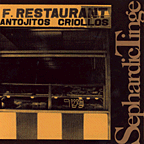Related info:
Other tzadik albums reviewed on these pages:
New Klezmer Trio
Melt Zonk Rewire
tzadik, 1995 (TZ 7103)
David Krakauer
Klezmer Madness
tzadik, 1995 (TZ 7102)
Anthony Coleman also records on the Knitting Factory label

Anthony Coleman Trio
Sephardic Tinge
tzadik, 1995
61 E. Eighth St., Suite 126, New York, NY 10003
Anthony Coleman Trio / Sephardic Tinge
Anthony Coleman: pianoGreg Cohen: bass
Joey Baron: drums
- Quando El Rey Nimrod (trad. Sephardic) 4:02
- Bye-Ya (Thelonius Monk) 5:11
- Ladino Passacaglia (Anthony Coleman) 5:06
- Belz (Alexander Olshanetsky-Jacob Jacobs) 4:54
- Bert Williams (Jelly Roll Morton) 4:04
- Sarajevo (Anthony Coleman) 4:17
- Doina (Anthony Coleman) 8:06
- Ask Anthony 2 (Coleman-Cohen-Baron) 6:14
- Una Matica De Ruda (trad. Sephardic) 6:32
This isn't really klez. It's very nice piano jazz, with some pleasant touches of the edge, and occasional Jewish themes. I like the album a lot, although it is, at best, at the edge of the music I am most interested in presenting here on the Klezmer pages. I do so in part because, as I said, I like the album--I like it's general quietness, I like the explorations and thoughtfulness, and I like the idea of thinking about a jazz album put together by someone self-consciously trying to reflect his Jewishness. In this case, that is a Jewishness not much informed by Ashkenazic culture, the culture of European Jews, but of Sephardic culture--that more closely and directly tied to the Golden Age of Spain, and it's rhythms and language. There is some irony, too, as today we tend to think of Spanish, the language, as integral to Sephardic culture, yet it was with the advent of the rule of Christian, Spanish-speakers that "culture" in that context was replaced by the Inquisition, and Sephardic culture spread to Europe through France and Holland, and to North Africa. (Yes, I simplify, but this is the mind wandering under the influence of this album.) I also like, for reasons having more to do with the emotion of the name, and only now the music, that Coleman has chosen to do a song titled "Sarajevo," commemorating what was once a thriving Jewish community in what was once the cosmopolitan, Christian, Turkish, Jewish crossroads of the Balkans. Before the recent factionalist murders began, one could visit Sarajevo and find copies of the Sarajevo Hagaddah dominating the city's tourist office. There was, and perhaps still is, a lovely Jewish museum in what had once been the community synagogue. This, despite the fact that the Nazis had destroyed most of the remaining Sarajevo Jewish community during the Holocaust. And, yes, I think you can hear a lot of that in this piece.
In the liner notes, Coleman explains, "I wanted to stay away from Klezmer as a basis for music reflecting Jewish identity. Poor Klezmer! A music which most of us had never heard until the mid- to late-70s has to stand for a completely hybrid and fragmented culture--New York Jewish Culture. I started thinking about the music which had accompanied most of my life in some way or another, I thought about the fact that the Mambo and Cha-Cha had both been dance crazes in the Borscht Belt during the '40s and '50s. I thought about Sephardic (Spanish) Jews and how strange and mysterious I had always found the idea of their language, Ladino. I added to this the uses that Jazz composers have made of what Jelly Roll Morton called 'Spanish tinge,' Habanera and Mambo patterns, montunos... thus the Morton and Monk pieces...."
Reviewed by Ari Davidow, 7/3/95

